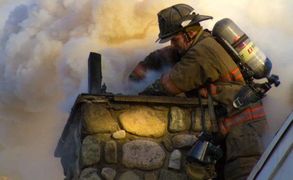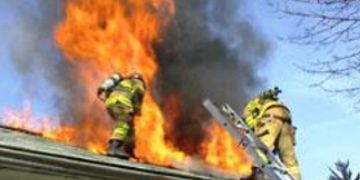Chimney Fires

Chimney fires are rare events, which is why we should review our tactics for them every season to ensure a quick effective coordinated attack. Doing this will help prevent chimney fires from becoming all-out structure fires. If not controlled quickly, chimney fires have the potential for interior and exterior fire spread.
Chimneys are vertical structures that ventilate smoke or hot gases from boilers, oil burners, fireplaces, stoves and furnaces to the outside atmosphere. The inside of a chimney is called the "flu" which is a duct or pipe that exhausts smoke and gas from fireplaces, furnaces, water heaters etc.. Chimneys have many uses from burning wood to provide heat in a home, to venting an incinerator in a highrise apartment building. We should prepare for fires involving the common types of chimneys in our response areas.
Chimney fires are not a regional issue, they occur in urban, suburban, metropolitan, and rural areas consisting of residential and commercial occupanices.
My career department is an urban department in the northeast with numerous ordinary and wood-frame constructed rowhomes, semi-detached homes, residential highrises, and taxpayers. From a fire standpoint, concerns in the city will most likely involve residential chimneys with oil burners located in the basement or cellar.
My suburban department is mostly wood-frame single family homes, non-combustible commercial and retail properties. From a fire standpoint, the chimney concerns there involve SFD's burning wood to heat the home, with most fireplaces located on the first floor. These have the potential for interior and exterior fire spread from stray or unattended embers, creosote buildup, or liner penetration.
In general, regardless of region, all types of chimneys with various construction will be located somewhere in your response area. Most are of brick/masonry and have tile, terracotta or metal flues. Older homes may not have a flue at all. Whether you are an urban, rural, or suburban department, every year prior to chimney season (usually the fall) schedule a chimney fire training review. Make sure the engine and ladder company work together to control these fires early.
A reported chimney fire should require a structure assignment response as additional manpower will be required to effectively mitigate a chimney fire. Most chimney fires are contained fires, but if not controlled quickly, can extend to the roof, cockloft, attic, basement, and the exterior.
Most chimney fires are caused by highly combustible creosote build up in the flue. Cracks and openings in the flue with exposure to wooden structural components can also start a fire. Flames, sparks, and fast moving dense smoke accompanied by a roaring sound are sure signs of a chimney fire. These fires can burn up to 2000°F destroying liners, bricks, masonry materials and contributing to fire spread in combustible parts of the structure. A well coordinated effort will be needed to extinguish the chimney fire before spreading to the rest of the structure. In the video below, the chimney fire extended to the structure.
Chimney Sweep

Basement vs Chimney

Photo courtesy of The Chimney Safety Institute
Arriving to think black pressurized smoke exiting from the chimney are signs of a chimney fire, and possibly a basement fire.

Photo courtesy of The Chimney Safety Institute
Before dropping chains, consider an attack from below sending dry chem up the flue to knock down most of the fire.
Roof Extension

Chimney fires can extend to the roof, resulting in an all-out structure fire.
Exterior Extension

Photo by 911 Photography
Chimney fire with extension to the exterior of the structure.
Aerial/TowerUse

Photo by Tonya Woodard
Aerial or tower ladders are ideal for chimney fires, especially when there's extension to the roof area.
This chimney fire extended to the structure. They worked safely from the aerial and roof ladders opening up to extinguish the extended fire saving the structure.
Modesto firefighters first put out the fire that was in the bottom of the fireplace, turned off the utilities to the house, and checked for spread of the fire, before turning their attention to the remaining fire in the chimney itself. Firefighters used a chainsaw to cut into the side of the chimney to extinguish the raging fire and were able to save the home from major damage.

Collapse of the chimney can seriously injure unsuspecting firemen below. Most chimneys in older cities are in poor condition and made of brick. Most of these bricks are cracked, lost their adhesiveness, and are being held up by gravity. Establish a collapse zone under the area of the chimney.
Using water to extinguish a chimney fire may cause spalling and further damage the chimney. The best method is to use dry chem powder. If using a hoseline is the only option on the roof to extinguish a chimney fire, apply short bursts of water to the top as shown in the video below.
Advise the property owner to have the chimney serviced/cleaned/repaired and check CO levels before leaving.
Chimney Fire SFD
Engine Company: Stretch a line to the interior and quickly determine the source, whether it’s an oil burner, fireplace or a basement fire. Place salvage covers/floor runners in the area to prevent doing further damage to the property. Using a water can to extinguish a small class A fire is acceptable if outside the container of fire involvement. Fires at the base inside the container may require a dry chem extinguisher, which will draw the powder upward. Bring shovels and place any smoldering creosote/wood/embers into a metal bucket and take it outside for extinguishment. Send a company to the attic/cockloft to check for extension. Monitor CO readings in the structure after the fire has been extinguished and ventilate accordingly.
Ladder Company: Size up the chimney roof area for access and egress. It may take up to three different types of ladders to access the top of the chimney. It may be safer to put the aerial ladder up or work off of a platform. Bring the chimney kit consisting of chimney sweep chains, mirror and TIC. Additional equipment such as hand tools/hooks, flashlight, chimney bombs (dry chem powder in bags) and possibly a saw may be needed to dig out the roof area near the chimney. Remove the chimney cap, fencing (bird cage) and any other debris from the top of the chimney. Dropping the chimney bombs down the chimney is very effective as the bag will melt with powder being naturally drawn up the chimney. Lower the weighted chimney chains from the top of the chimney down the flue to knock the creosote off the walls into the base container area, to be removed and extinguished. Check for extension at the base of the chimney near the flashing.
DO NOT LOOK DOWN THE CHIMNEY (Use a mirror)
Water was chosen for this chimney fire because the fire department was familair with the residence from prior fires involving the chimney and were concerned the flue was compromised .
Extinguishment from below had already been attempted without success. Water fog was used, the chimney cleaned by TFD using both a trash hook and a commercial chimney sweep, and the homeowner was advised NOT to use the chimney further until inspected and repaired.


A volunteer Assistant Chief was seriously injured, and 2 volunteer firefighters were injured while fighting a townhouse fire in Delaware. The fire originating in a chimney in a walk-out basement of a town house unit and extended to floors and the attic via the “flue box” enclosure. The flue enclosure was interconnected with the spaces between the ceiling and floors created by the parallel chord floor trusses. Conditions rapidly deteriorated forcing firefighters to bail out a window and quickly exit the structure. Firefighters suffered burns and smoke inhalation. See NIOSH report below.
Basement & Cellar Fires In Taxpayers, Garden Apartments...
Policy Page
PLEASE NOTE
The login above DOES NOT provide access to Fire Engineering magazine archives. Please go here for our archives.
CONTRIBUTORS NOTE
Our contributors' posts are not vetted by the Fire Engineering technical board, and reflect the views and opinions of the individual authors. Anyone is welcome to participate.
For vetted content, please go to www.fireengineering.com/issues.
We are excited to have you participate in our discussions and interactive forums. Before you begin posting, please take a moment to read our community policy page.
Be Alert for Spam
We actively monitor the community for spam, however some does slip through. Please use common sense and caution when clicking links. If you suspect you've been hit by spam, e-mail peter.prochilo@clarionevents.com.
FE Podcasts
Check out the most recent episode and schedule of UPCOMING PODCASTS
Podcast Archive
Groups
-
Unique HazMat Incidents
45 members
-
Haz-Mat
116 members
-
National Fallen Firefigh…
62 members
-
Operational Guides
73 members
-
"Outside The Box" Engine…
166 members
-
Engine Company Ops
65 members
-
Fire Service Leadership
277 members
-
COMPANY DRILLS
510 members
-
Swiftwater Rescue
10 members
-
Step Up and LEAD
106 members
© 2025 Created by fireeng.
Powered by
![]()

You need to be a member of Fire Engineering Training Community to add comments!
Join Fire Engineering Training Community